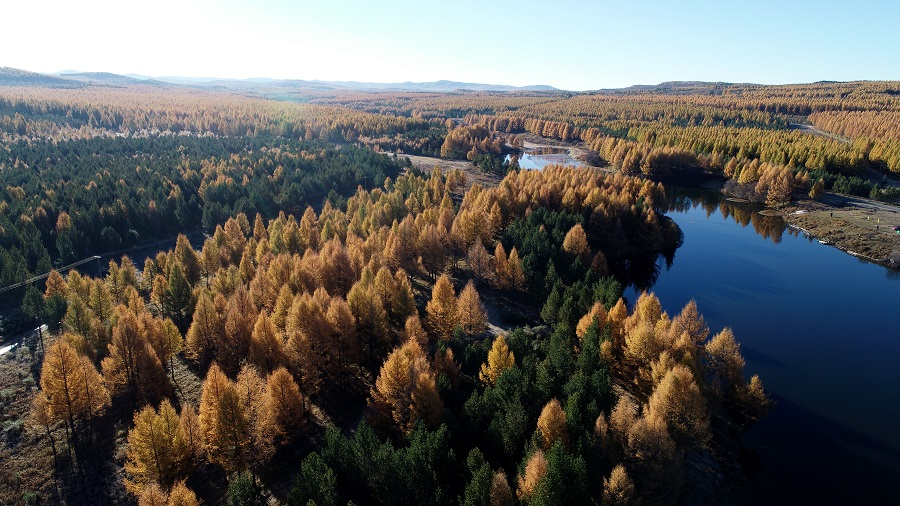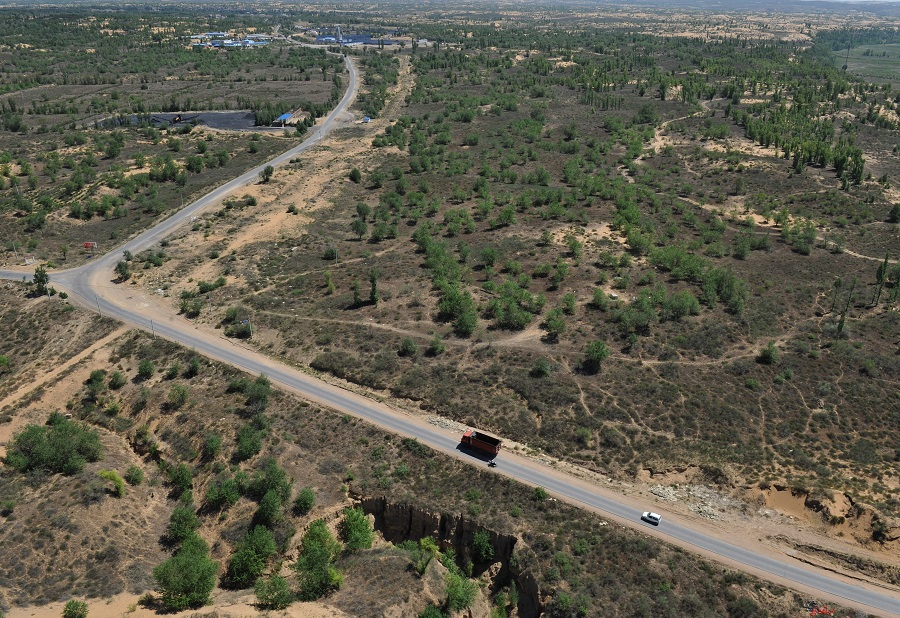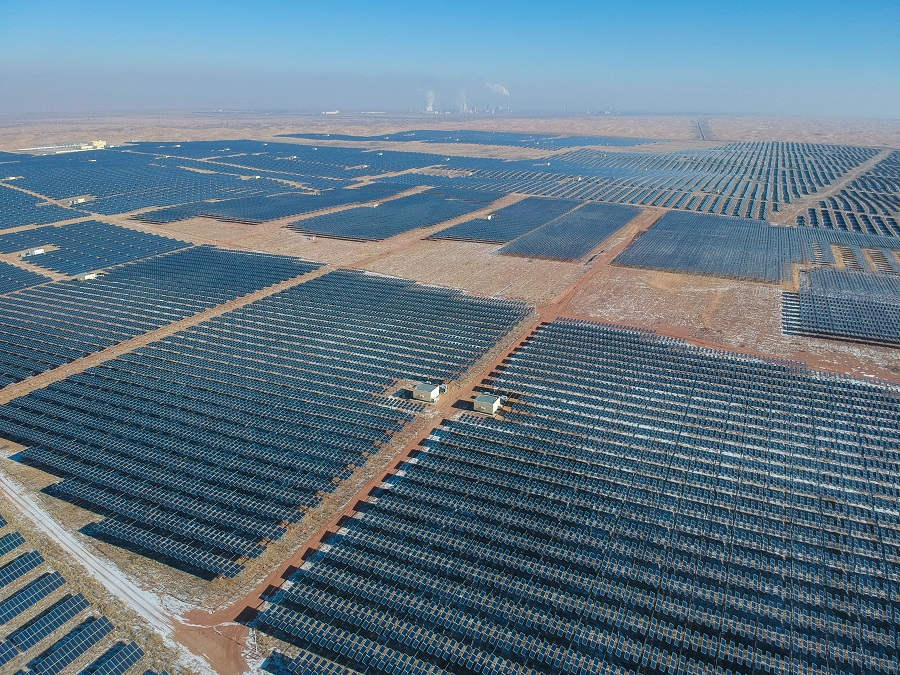Desertification, a form of environmental degradation, is a problem affecting over 100 countries worldwide. Since the founding of the People’s Republic of China (PRC), the Chinese government has established plantations, installed shelterbelts as windbreaks and for sand stabilization, and launched large-scale reforestation campaigns in order to stop the desert’s encroachment. China’s greening of the Kubuqi Desert, in particular, has received much attention in recent years. It has become known as the Kubuqi Model, providing a new solution for desertification control.
The year was 1964. Nineteen-year-old Chen Yanxian (陳彥嫻) could scarcely contain her excitement arriving at Saihanba Forest Farm (塞罕壩林場) in northern Hebei to start her new job. Back in the Qing dynasty, Saihanba had been a key part of the famous royal Mulan Hunting Grounds (木蘭圍場) .Yet when Chen Yanxian arrived, what greeted her was a barren, sandstorm-ravaged land. Covered in snow for an average of seven months a year, its winter temperature reached an extreme low of minus 43.3 degrees Celsius at times.
The harsh working conditions at the forest farm left a great impression on Chen Yanxian: the repetitive sowing and cultivating of seedlings caused her hands to break out in blisters; at times, her arms became so swollen that she could barely raise them; during the winter, her sweat-soaked padded jacket froze solid and clunked with a wa-wa sound with every move.
Despite the unforgiving environment, the Saihanba Forest Farm workforce succeeded in building a man-made forest of over 750-square km - the greatest in the world - as an important eco-barrier protecting Beijing, Tianjin and surrounding regions from desertification.
Over the course of PRC’s 70-year battle against desertification, countless people like Chen Yanxian have toiled silently to combat the sands in different parts of China, all sharing a common goal; to control desertification, quell the sandstorms and lay the path for nature’s green return.
Confronting desertification
Desertification, the transformation of arable land into desert, is a problem affecting more than 100 countries world-wide. Its causes can be natural or anthropogenic (i.e. those involving human behavior). Natural factors such as climate anomalies and changes in ocean current circulation, when in effect for a long period, can cause large-scale desertification. Anthropogenic factors include unsustainable land clearance, overgrazing and misuse of water resources. In the 20th century, rapid population growth has exacerbated these processes and caused desertification to accelerate. This has resulted in the loss of arable land, sandstorms and the degradation of ecosystems. All pose a grave threat to human survival and social development.
In Northern China, most land is located in arid and semi-arid zones, making the region particularly prone to desertification. The ecosystems there have always been vulnerable, thus preventing desertification is a major priority that calls for long-term commitment.
When the PRC was founded, the need to develop agriculture and improve livelihoods brought the issue of desertification and the threat it posed to the government’s attention. In an effort to curb sandstorms, wind-breaking and sand-fixing shelterbelts were constructed in various regions including the sandy lands in the Hutuo River Basin (滹沱河流域) in Hebei, the Yellow River floodplain in Yudong (豫東) (East Henan) the eastern edge of the Ulan Buh Desert (烏蘭布和沙漠) and the sandy lands in the western parts of northeastern China and Yulin (榆林) in northern Shaanxi. While relatively small-scale and installed in just a few key regions, they proved to be remarkably effective and many were maintained until the 1980s and 1990s.
In the 1960s China began to establish forest farms to boost its forest resources. Most were established on ecologically vulnerable areas, barren hills and abandoned land, an example being Saihanba. Pan Wenxia (潘文霞) a retired staff member, recalled Saihanba’s early days. “Back then, sandstorms were common in Saihanba. The major sandstorms were so bad that you couldn’t even see someone standing an arm’s length away.”
In fact, in the first two years, Saihanba’s sandstorms were so severe that over 90 percent of the seedlings planted by the team died. Over time, though, Saihanba’s forest cover grew steadily from 12 percent at the launch of the initiative to 80 percent today, while forest stock volume also increased from 330,000 cubic meters to 10,120,000 cubic meters. In 2017, the Saihanba initiative received the Champions of the Earth Award, the United Nations’ highest environmental honor.
On another front, the nation also began conducting scientific research on desert-oriented geography, vegetation, soil and forestry back when desertification first became a concern. In April 1952, to stop the Horqin sandy land (科爾沁沙地) from encroaching southward, the Zhanggutai Sand Fixation Afforestation Experimental Station (章古台固沙造林試驗站) was established at Zhanggutai (章古台) in Zhangwu County (彰武縣) of Liaoning Province as PRC’s first research institute dedicated to the control of desertification. Desertification control was also key to the success of the Baolan (Baotou - Lanzhou) Line, proposed in the nation’s First Five-Year Plan as a railroad that would intersect the Tengger Desert (騰格里沙漠) at six different points. At that time, no country had ever succeeded in constructing and maintaining a railroad in the desert. To stop shifting sand dunes from burying the railroad, a desert experimental research station was established to find a way to stabilize the dunes. After numerous experiments, an innovative breakthrough enabled the railroad to become fully operational in 1958. In 1987, the Baolan Line’s desertification control and prevention program won the Special Award of the National Science and Technology Progress Achievement Award (國家科學技術進步獎). In 1959, the Chinese Academy of Sciences (中國科學院) formed a sand-control study team to conduct a comprehensive survey of major deserts and sandy lands all over the country and propose new solutions for controlling desertification.
However, from the 1960s to the mid-1970s extreme leftist thinking held sway over China and increasing grain yields became a national priority. With policies characterized by slogans such as “grain production as the chief objective” and “it is unethical for pastoralists to eat grain grown by others,” people strove to expand cropland by any means - clearing wastelands, removing forests and grasslands and converting marginal lands to agricultural land. This occurred on a massive scale all over the nation. As a result, forest and grassland ecosystems were ravaged; to make matters worse, many research projects on desertification control were forced to close.
Constructing a Green Great Wall
As the ecological environment in northern China continued to deteriorate in the 1970s, dust storms became more frequent. Back then, cities like Beijing, Lanzhou (蘭州) and Urumqi (烏魯木齊) saw over 20 dust affected days a year while Xi’ning city (西寧) reported 57.8 such days a year. The Ningxia Forestry Chronicles (寧夏林業志) contains a passage that describes the devastating might of a dust storm:
“Darkness filled the sky and covered the land, blotting out the sun and moon; men and livestock in the storm’s path were swept away, trees were toppled and houses were destroyed. The losses were catastrophic.”
The storms imperiled the livestock industry and exacerbated erosion and drought. Desertification became a calamity and controlling it a matter of great urgency.
In November 1978, China launched the Sanbei Shelter-forest Project (三北防護林體系建設工程) a large-scale afforestation project that would span northwest, north, and northeast China. The project, to be completed in 70 years in seven phases, started with the mass planting of fast-growing poplar trees. While these trees performed well in the summer, they were less effective as a barrier in the winter after shedding their leaves and going into hibernation. Also, the lack of species diversity increased their vulnerability to pests. As a result, they often died en masse, to the distress of the villagers who planted them. The method was later improved with a combination of trees, shrubs and grasses being planted together, creating vegetation cover more resilient to natural conditions.
Now, 40 years into the Sanbei Shelter-forest Project, the hard work has yielded remarkable results: Shifting sand dunes have been converted into semi-fixed and fixed dunes by the grasses; the regional climate has also improved after the establishment of vast tracts of trees and shrub. From 1978 to 2018, China's forest coverage increased from 5.05 percent to 13.57 percent, while its forest stock volume grew to a total of 1.26 billion cubic meters. The significant increase in food and timber yields also helped augment farmers’ income.
Besides the Sanbei Shelter-forest Project, there is also the Beijing-Tianjin Sandstorm Source Control Project (京津風沙源治理工程) another flagship project designed to rein in and combat desertification. It was initiated in the spring of 2000 by the State Council, when North China experienced 12 major episodes of serious dust and sand storms air pollution. Even the capital was repeatedly affected. While the project’s main objective is to establish tree and grass cover, it features some comprehensive supporting measures like the construction of small-scale waterworks, introduction of water-efficient irrigation and relocation of residents from ecologically fragile locations. The first phase of the project, which concluded in 2012, created 7.53 million hectares of new forest. According to monitoring data, the average number of dangerously dust polluted days in Beijing fell from over 13 times a year during the 2000-2002 period to just two to three times a year in the 2010-2012 period. In 2014, no dust pollution days were reported.
Several programs were launched in succession representing different approaches to restoring the health of the ecosystem. They include the Conversion of Cropland to Forest and Grassland Program (退耕還林還草工程) in 1999, the Natural Forest Protection Program (天然林保護工程) in 2000 and the National Wildlife Protection and Nature Reserve Construction (野生動植物保護及自然保護區建設工程) in 2001.
The 2014 findings of the Fifth National Monitoring Survey of Desertification and Sandification (全國第五次荒漠化和沙化監測) showed the area of land affected by desertification and sandification in China accounted for 27.20 percent and 17.93 percent of its total area respectively. This had remained more or less constant for the previous 20 years, a sign of the nation’s success in curbing desertification.
Besides launching special major projects, China has reinforced its environmental protection laws and signed international conventions to combat desertification after reform and opening-up: in 1991, the State Council approved the National Planning Program for the Control of Desertification in 1991-2000, which accorded desertification control special project status; in 1994, China signed the United Nations Convention to Combat Desertification to join forces with the international community in pursuing sustainable development and controlling desertification; and in August 2001, China passed the Law of the People's Republic of China on Desert Prevention and Transformation (中華人民共和國防沙治沙法) the world's first law dedicated to desertification prevention and control, to take effect the following year.
The Kubuqi Model
Kubuqi, one of China’s seven great deserts, is located within the Ordos area of Inner Mongolia, on the southern bank of the Yellow River. Life was harsh three decades ago. A local resident recalled: “In the spring, our faces were stinging from the sand the fierce wind pelted at us; with the desert encroaching and the pastures in decline, our sheep were all emaciated.”
The shifting sand dunes at the northern end of the Kubuqi Desert were in danger of slipping into the Yellow River and causing mass land erosion; desertification control was imperative.
In Kubuqi’s case, sand fixation was achieved by the traditional methods of afforestation and grass cultivation as well as a brand new technology that made use of algae as a biological sand-fixing agent. After application, it took root and proliferated in the desert within a few months. The combined use of trees, shrubs, grasses and algae was able to restore stability to Kubuqi’s fragile ecosystems.
The bulk of the sand fixing was performed by the plant species Salix psymmophia. It is drought- and wind-resistant and can be used as a fuel and source of fiber for textiles and paper. However, it is difficult to cultivate. Gao Linshu (高林樹) a villager, recounted his efforts to propagate the cuttings in sand: “they died and we had to replant them, until we lost count of how many times it happened.”
According to Gao Linshu, he and fellow tree planters spent most of the year planting trees in sandy areas. Even when traveling from one area to another, they kept an eye out for stray seeds or seedlings they could use for their cause. Their work began to pay off five years later when the Salix psymmophia matured enough to provide shade and allow the soil to retain traces of moisture. To ensure that a portion of propagated plants survived, mechanical sand barriers were also installed as a supporting mechanism for combating desertification. This proved more effective than relying solely on plants for sand fixing.
While controlling desertification, people began to explore desert-based industries that would cash in on the Kubuqi’s unique climate, abundant sunlight and other physical assets. The cultivation of lucrative medicinal desert crops like licorice and desert-broomrape took off; as did the use of Salix psymmophia and other sand-fixing plants as raw materials for the production of compound animal feed. Next was the installation of a photovoltaic power base to capture the Kubuqi’s abundant solar energy. The photovoltaic panels created shade, enabling the cultivation of alfalfa, which served a dual purpose, as a soil improver and animal feed. Tourism, too, was promoted with zeal. The Kubuqi area boasted expansive grasslands, desert scenes and wetlands that served as tourist magnets. Desert forest parks, desert lake parks and resorts were established - provided that they would not affect the wind-breaking and sand-fixing shelterbelts - and thus a desert-themed eco-tourism industry with its own unique vibe came into being.
Desert-broomrape: a parasitic plant that lives on the roots of the saxaul, a desert tree. Dubbed the “desert ginseng” for its many medicinal properties, it is prized by traditional Chinese medicine practitioners.
Alfalfa: a perennial herbaceous plant that resembles clover. It is drought and cold resistant and can improve soil fertility. It is mainly harvested for hay, fed to livestock as greenchop or grown as pasture.
In the present-day Kubuqi Desert, one can stand atop a sand dune and pick up some un-desert-like sensations: a gentle breeze, soothing birdsong and the faint scent of vegetation. In 2014, the Kubuqi Desert ecological management area was lauded as a “global ecological and economic demonstration zone” by the United Nations Environment Programme; in 2017, Wang Wenbiao (王文彪) who spearheaded the Kubuqi desertification control effort, was honored with the United Nations Champions of the Earth - Lifetime Achievement Award. The Kubuqi Model achieved international fame as a successful strategy for combating desertification.
China’s long experience in controlling desertification came with a lesson; we are inseparable from nature and its wellspring of solutions. While it is unrealistic to strive to wipe deserts off the face of the Earth altogether, we can work to build oases around them and curb their expansion. Coexisting in harmony with the desert is the best way forward, and in return, the desert will reward those who tread nature’s green path with respect and understanding.
References:
A Green Dream Forged through Sheer Will - Interview of Chen Yanxian, First-Generation Worker of Saihanba Forest Farm (意志和信念鑄就了這片綠色——訪第一代塞罕壩林場工人陳彥嫻) hebei.com.cn, Dec. 6, 2017
“Tide Player”· Combating Desertification in the Kubuqi: From One Tree to a 190,000-mu Forest (「弄潮」·庫布齊治沙:從一棵樹到19萬畝林) The Beijing News, Dec. 24, 2018
China’s Sanbei Forest Shelter Project: Current Status and Musings (中國「三北」防護林工程建設現狀及思考) Zhao Ziye (趙子夜), Journal of Nanjing Forestry University (Humanities and Social Sciences Edition) (南京林業大學學報(人文社會科學版)) 2018 Issue 3
The Kubuqi Desert: A Classical Model of Ecological Management and Development and Use (庫布齊沙漠生態治理與開發利用的典型模式) Guo Caiyun (郭彩贇) et al., Journal of Northwest Normal University (Natural Science) (西北師範大學學報(自然科學版)) 2017 Issue 1
A Comprehensive Review of Desertification Prevention and Control in China (我國防沙治沙綜述), Qi Youxiang (祁有祥) Zhao Tingning (趙廷寧) Journal of Beijing Forestry University (Social Sciences) (北京林業大學學報(社會科學版)) 2006 Issue S1









